
Making the door partition do it yourself. Instructions for the manufacture of sliding doors of partitions Doors
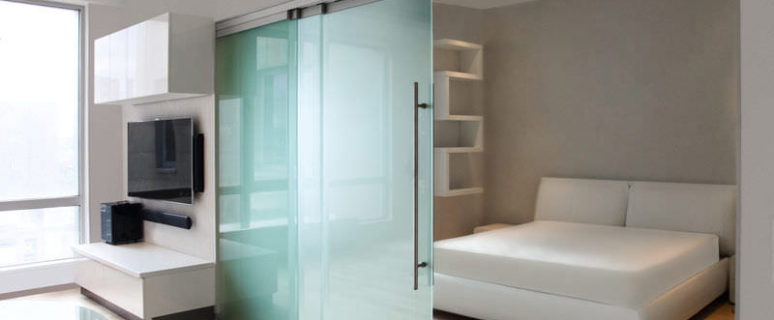
Sliding partitions are an alternative to conventional sliding doors. Their design is more complicated, but thanks to her living in the apartment have the ability to change the interior or retire even in a limited space.
Content
Types of sliding partitions
In order to properly choose the door partition from the entire variety of species, it is necessary to take into account its functional purpose. With the help of sliding partitions, the following tasks can be implemented:
- separation of various apartments for the purpose of the apartment (living room from the kitchen, hallway from the living room, etc.), which is often implemented in studio apartments;
- fence of the openings used as wardrobes, subsidies, places of concentration of engineering communications;
- thermal insulation of the premises.
The design of the partition doors is two types.
- With the bottom guide (rail): Doors move on the principle of the cabinet, whose rollers are based on the lower edge on the rail. Opening and closing of such partitions occurs almost silent.
- Without the lower guide (unheard): The movement mechanism is located exclusively at the top. Such a system is more convenient, since there is no obstacle to walk on the floor.
- Door-harmonica: in the folded state take up little space.
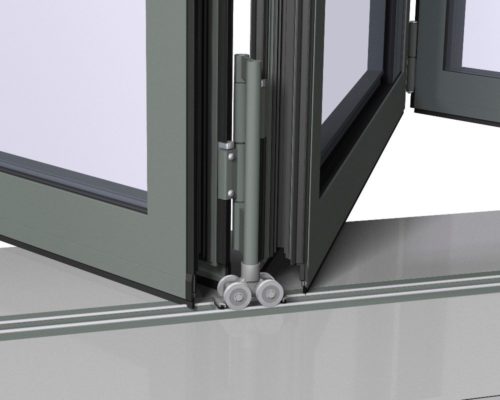
Partition Doors with lower guide
Classification of sliding partitions in the form of a guide profile:
- straight;
- radial curved;
- angle (sash in a closed position closed at right angles).
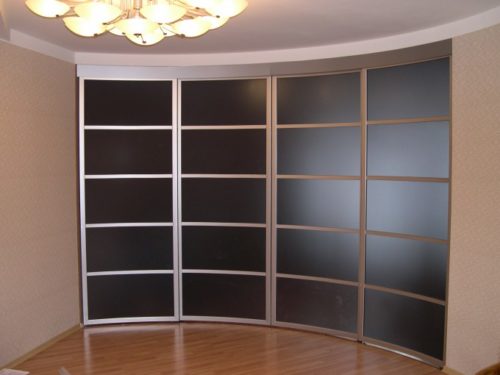
Radial curved doors partition
Depending on the manufacturing material, sliding structures are divided into:
- plastic interroom partitions;
- stained-glass;
- glass partition doors;
- with DSP or PVC sash;
- frame-fabric;
- interior wood partitions.

Wooden sliding partitions
Sliding doors also differ in weight, translucency, color and other characteristics, which should also be considered when choosing.
How to make sliding door partitions do it yourself
In the event that the material from which the sliding interior partition will be made, the features of its design and installation site, can be proceeded.
Preparation for the installation of partitions
The whole process can be divided into several stages.
- It is measured by the opening: it is necessary to know the width of the base, the width of the ceiling, the height of the left and right. Diagonal is compared: their discrepancy should not exceed 1.5 cm. The side sides should be strictly vertical (deviation is allowed to 0.5 cm).
- In the event that the parameters of the opening have significant deviations from the norm, it is necessary to correct them. For this use plaster or facing panels. The same must be performed if the strength of the workshop is insufficient to withstand the weight of the sliding structure.
- Knowing the opening parameters after leveling and strengthening its sides, the dimensions of the sliding doors determine. It is necessary to take into account the size of the mechanisms and guides necessary to move the shutters.
- Selected material for partitions. Production of details from chipboard or glass, joinery is recommended to book on a specialized enterprise.
- In a construction supermarket, guides are purchased with rollers and fastening parts.
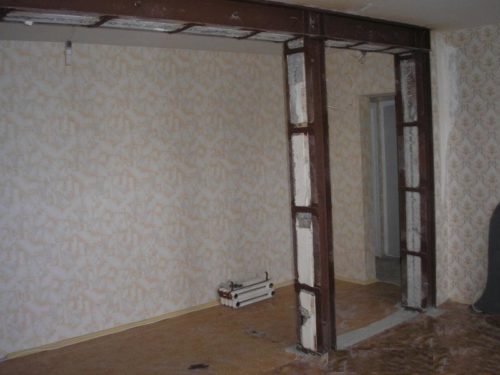
Strengthening the opening of the opening of metal corners
Tip: Choosing a sliding system, rubber rollers prefer metallic, as their service life is several times greater. Rubber rollers at intensive load can only be enough for several months.
Assembly and installation of partition doors
In the accompanying documentation, we study the requirements for the installation of interroom partitions. We check the complete set and purchase additional fasteners (considering the feature of the material of the opening) and accessories. At your disposal should be materials and tools for mounting door partitions from the list:
- construction level;
- plumb;
- marker for marker or carpentry pencil;
- perforator;
- electric drill;
- tree milling mill (for mounting embedded rollers);
- screwdriver or screwdriver set;
- scotch bilateral;
- roulette;
- bulgarian or scissors for metal;
- profiles of the upper and lower guides;
- details of edging of sash;
- hinged (upper) and support (lower) rollers;
- fastening details (self-tapping and dowel-nails with countersunk hats);
- cloth sliding design.
Important: The number of hinged and supporting rollers depends on the width and weight of the flaps. For light structures of small size, it is enough to install in a pair of rollers of each type.
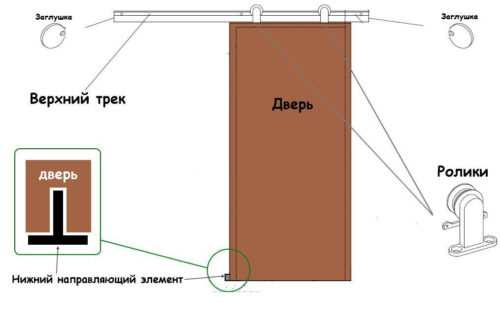
Total shift partition scheme
Description Installation technology:
- As indicated in the recommendations on the installation of partitions, fastened attached and support rollers, respectively, in the upper and lower part of the canvas. If the mounted mechanisms are embedded - to install them, we make a sample of grooves by a mill.
- Fresh accessories: handles and loops for connecting sash, seating parts.
- We prepare the guides: the extra length of the profile is spawn with a grinder or hand-hacking for metal.
- At the top of the opening, we set the corresponding guide. First we apply it to the horizontal surface and mark the place for fastening. To fix the guide, it is convenient to use bilateral tape.
- For fixed cloth, install the stopper.
- Arrow holes for plastic dowels for self-tapping screws.
- With the help of a plumb, we determine and mark the average line, which will be attached to the bottom rail.
- We note the place to twist the screws and the attitudes of the rail.
- We establish the sliding partitions in the opening: first inspired to the upper guide, after which, lifting the sash to the maximum, insert the lower rollers in the slope of the lower rail.
- We check the operation of the system: it is important that the partitions be easily moved by guides without distortion and jamming. Spontaneous sash rolling should not be. Side parties should be tightly approaching the planes of the opening. In case of detection of deviations from the requirements, adjustment is performed (adjusting screws are listed in the installation instructions).
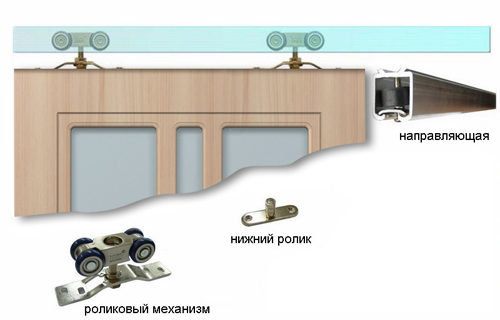
Installation of rollers
Detailed information about each stage of installation is set out in the following video.
Decorating sliding door partitions
Sliding partitions can be decorated both before they are installed and after. There are several decoring methods.
- Glass matting: For this, a special matting fluid is used, which is applied to free surface areas. Zones that do not have to purchase a matte effect are sealed with scotch. As a result, a drawing conceived by designer is formed on the glass.
- Application patterns with paint. To get a stained in paint, you need to dissolve 5 g of gelatin in 100 g of water, then add a dye from the freaker of the desired color or use colored ink. Ready stained glass paints can be purchased in an art salon.
- Application with color films. For this, self-adhesive films of different colors are used. They can be transparent and not transparent. The shapes are cut with a sharp blade, and then gluke on a preventive glass.
- Wood carving, burning. These decoring methods can be used for partitions made of natural wood.
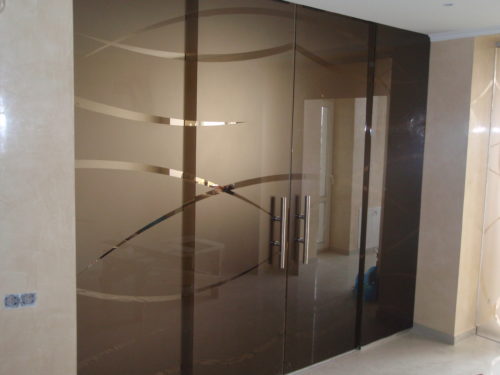
Matted glass partition
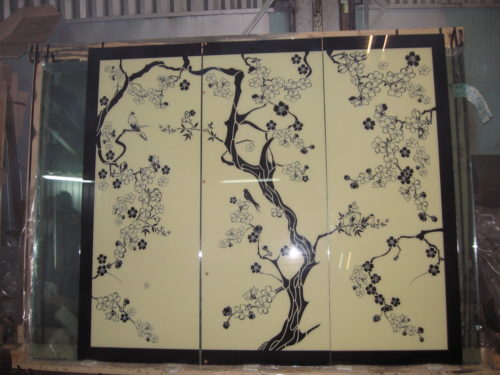
Flashing glasses with colored film
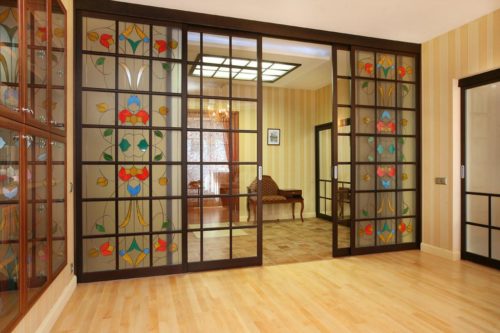
Art Painting Glass Partition
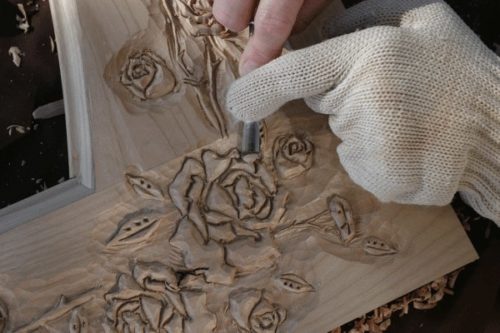
Wood carving
Some ideas for the manufacture and installation of partitions can be borrowed from the following plot. To your attention - partition door in the interior (video).


















